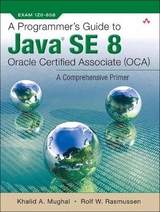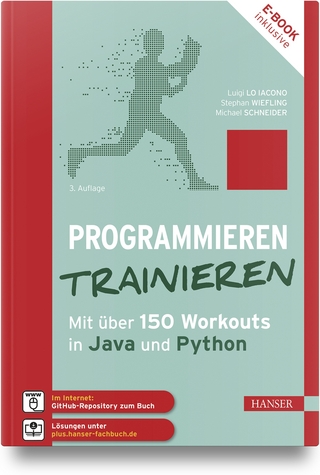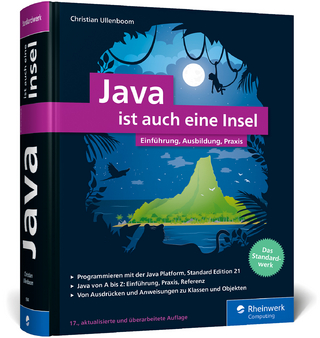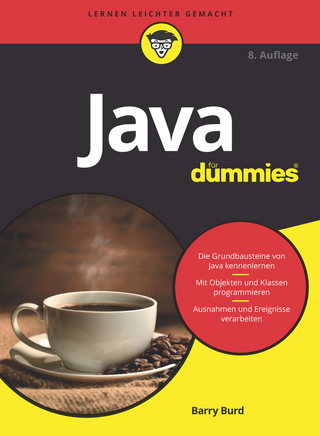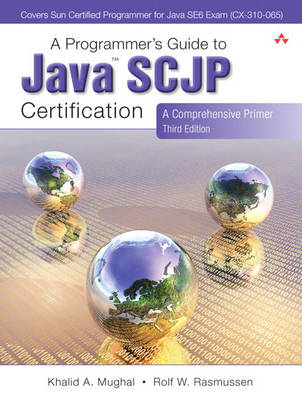
Programmer's Guide to Java SCJP Certification, A
Addison-Wesley Educational Publishers Inc (Verlag)
978-0-321-55605-9 (ISBN)
- Titel erscheint in neuer Auflage
- Artikel merken
A Programmer’s Guide to Java™ SCJP Certification, Third Edition, provides detailed coverage of all exam topics and objectives, readily runnable code examples, programming exercises, extensive review questions, and a new mock exam. In addition, as a comprehensive primer to the Java programming language, this book is an invaluable reference tool.
This new edition has been thoroughly updated to focus on the latest version of the exam (CX-310-065). In particular, it contains in-depth explanations of the language features. Their usage is illustrated by way of code scenarios, as required by the exam. The companion Web site (www.ii.uib.no/~khalid/pgjc3e/) contains a version of the SCJP 1.6 Exam Simulator developed by the authors. The site also contains the complete source code for all the book’s examples, as well as solutions to the programming exercises.
What you will find in this book:
Extensive coverage of all the objectives defined for the Sun Certified Programmer for the Java Platform, Standard Edition 6 (CX-310-065) Exam
An easy-to-follow structure with chapters organized according to the exam objectives, as laid out by Sun Microsystems
Summaries that clearly state and differentiate the exam objectives and the supplementary objectives to be covered in each chapter
A list of Sun’s objectives for the SCJP 1.6 Exam and a guide to taking the exam
A complete mock exam with new questions (not repeats of review questions)
Numerous exam-relevant review questions to test your understanding of each major topic, with annotated answers
Programming exercises and solutions at the end of each chapter
Copious code examples illustrating concepts, where the code has been compiled and thoroughly tested on multiple platforms
Program output demonstrating expected results from running the examples
Extensive use of UML (Unified Modeling Language) for illustration purposes
An introduction to basic terminology and concepts in object-oriented programming
Advice on how to avoid common pitfalls in mastering the language and taking the exam
Platform- and tool-independent coverage
Information about the SCJP 1.6 Upgrade (CX-310-066) Exam
Khalid A. Mughal is an Associate Professor at the Department of Informatics at the University of Bergen, Norway. Professor Mughal is responsible for designing and implementing various courses, which use Java, at the Department of Informatics. Over the years, he has taught Programming Languages (Java, C/C++, Pascal), Software Engineering (Object-Oriented System Development), Data bases (Data Modeling and Database Management Systems), and Compiler Techniques. He has also given numerous courses and seminars at various levels in object-oriented programming and system development, using Java and Javarelated technology, both at the University and for the IT industry. He is the principal author of the book, responsible for writing the material covering the Java topics. Professor Mughal is also the principal author of an introductory Norwegian textbook on programming in Java ( Java som første programmeringsspråk/Java as First Programming Language, Third Edition, Cappelen Akademisk Forlag, ISBN-10: 82-02-24554-0, 2006), which he co-authored with Torill Hamre and Rolf W. Rasmussen. Together they have also published another textbook for a 2-semester course in programming ( Java Actually: A Comprehensive Primer in Programming, Cengage Learning, ISBN-10: 1844809331, 2008). His current work involves applying Object Technology in the development of content management systems for publication on the Web, and security issues related to web applications. For the past seven years he has been responsible for developing and running web-based programming courses in Java, which are offered to offcampus students. He is also a member of the Association for Computing Machinery (ACM). Rolf W. Rasmussen is the System Development Manager at vizrt, a company that develops solutions for the TV broadcast industry, including real-time 3D graphic renderers, and content and control systems. Rasmussen works mainly on control and automation systems, video processing, typography, and real-time visualization. He has worked on clean room implementations of the Java class libraries in the past, and is a contributor to the Free Software Foundation. Over the years, Rasmussen has worked both academically and professionally with numerous programming languages, including Java. He is primarily responsible for developing the review questions and answers, the programming exercises and their solutions, the mock exam, and all the practical aspects related to taking the SCJP exam presented in this book. As mentioned above, he is also a co-author of two introductory textbooks on programming in Java.
List of Figures xxiii
List of Tables xxvii
List of Examples xxix
Foreword xxxv
Preface xxxvii
Chapter 1: Basics of Java Programming 1
1.1 Introduction 2
1.2 Classes 2
1.3 Objects 4
1.4 Instance Members 6
1.5 Static Members 7
1.6 Inheritance 10
1.7 Aggregation 12
1.8 Tenets of Java 13
1.9 Java Programs 15
1.10 Sample Java Application 15
Chapter 2: Language Fundamentals 19
2.1 Basic Language Elements 20
2.2 Primitive Data Types 28
2.3 Variable Declarations 31
2.4 Initial Values for Variables 33
Chapter Summary 37
Programming Exercise 37
Chapter 3: Declarations 39
3.1 Class Declarations 40
3.2 JavaBeans Standard 41
3.3 Method Declarations 44
3.4 Constructors 48
3.5 Enumerated Types 54
3.6 Arrays 69
3.7 Parameter Passing 81
3.8 Variable Arity Methods 90
Chapter Summary 100
Programming Exercises 101
Chapter 4: Access Control 103
4.1 Java Source File Structure 104
4.2 Packages 105
4.3 Searching for Classes 117
4.4 The JAR Utility 120
4.5 System Properties 122
4.6 Scope Rules 129
4.7 Accessibility Modifiers for Top-Level Type Declarations 132
4.8 Other Modifiers for Classes 135
4.9 Member Accessibility Modifiers 138
4.10 Other Modifiers for Members 146
Chapter Summary 157
Programming Exercise 157
Chapter 5: Operators and Expressions 159
5.1 Conversions 160
5.2 Type Conversion Contexts 163
5.3 Precedence and Associativity Rules for Operators 166
5.4 Evaluation Order of Operands 168
5.5 The Simple Assignment Operator = 169
5.6 Arithmetic Operators: *, /, %, +, - 174
5.7 The Binary String Concatenation Operator + 185
5.8 Variable Increment and Decrement Operators: ++, -- 186
5.9 Boolean Expressions 190
5.10 Relational Operators: <, <=, >, >= 190
5.11 Equality 191
5.12 Boolean Logical Operators: !, ^, &, | 194
5.13 Conditional Operators: &&, || 196
5.14 The Conditional Operator: ?: 201
5.15 Other Operators: new, [], instanceof 201
Chapter Summary 202
Programming Exercise 202
Chapter 6: Control Flow 203
6.1 Overview of Control Flow Statements 204
6.2 Selection Statements 204
6.3 Iteration Statements 216
6.4 Transfer Statements 223
6.5 Stack-Based Execution and Exception Propagation 235
6.6 Exception Types 239
6.7 Exception Handling: try, catch, and finally 245
6.8 The throw Statement 255
6.9 The throws Clause 257
6.10 Assertions 265
Chapter Summary 279
Programming Exercises 279
Chapter 7: Object-Oriented Programming 283
7.1 Single Implementation Inheritance 284
7.2 Overriding Methods 288
7.3 Hiding Members 294
7.4 The Object Reference super 295
7.5 Chaining Constructors Using this() and super() 302
7.6 Interfaces 309
7.7 Arrays and Subtyping 317
7.8 Reference Values and Conversions 319
7.9 Reference Value Assignment Conversions 320
7.10 Method Invocation Conversions Involving References 323
7.11 Reference Casting and the instanceof Operator 327
7.12 Polymorphism and Dynamic Method Lookup 340
7.13 Inheritance Versus Aggregation 342
7.14 Basic Concepts in Object-Oriented Design 345
Chapter Summary 349
Programming Exercises 349
Chapter 8: Nested Type Declarations 351
8.1 Overview of Nested Type Declarations 352
8.2 Static Member Types 355
8.3 Non-Static Member Classes 359
8.4 Local Classes 371
8.5 Anonymous Classes 377
Chapter Summary 386
Programming Exercise 386
Chapter 9: Object Lifetime 389
9.1 Garbage Collection 390
9.2 Reachable Objects 390
9.3 Facilitating Garbage Collection 392
9.4 Object Finalization 396
9.5 Finalizer Chaining 397
9.6 Invoking Garbage Collection Programmatically 398
9.7 Initializers 406
9.8 Field Initializer Expressions 406
9.9 Static Initializer Blocks 410
9.10 Instance Initializer Blocks 413
9.11 Constructing Initial Object State 416
Chapter Summary 422
Chapter 10: Fundamental Classes 423
10.1 Overview of the java.lang Package 424
10.2 The Object Class 424
10.3 The Wrapper Classes 428
10.4 The String Class 439
10.5 The StringBuilder and the StringBuffer Classes 456
Chapter Summary 464
Programming Exercises 465
Chapter 11: Files and Streams 467
11.1 Input and Output 468
11.2 The File Class 468
11.3 Byte Streams: Input Streams and Output Streams 475
11.4 Character Streams: Readers and Writers 488
11.5 The Console class 500
11.6 Object Serialization 510
Chapter Summary 529
Programming Exercise 530
Chapter 12: Localization, Pattern Matching, and Formatting 531
12.1 The java.util.Locale Class 532
12.2 The java.util.Date Class 535
12.3 The java.util.Calendar Class 536
12.4 The java.text.DateFormat Class 541
12.5 The java.text.NumberFormat Class 546
12.6 String Pattern Matching Using Regular Expressions 554
12.7 Formatting Values 593
Chapter Summary 610
Programming Exercises 610
Chapter 13: Threads 613
13.1 Multitasking 614
13.2 Overview of Threads 614
13.3 The Main Thread 615
13.4 Thread Creation 615
13.5 Synchronization 626
13.6 Thread Transitions 634
Chapter Summary 658
Programming Exercises 659
Chapter 14: Generics 661
14.1 Introducing Generics 662
14.2 Generic Types and Parameterized Types 663
14.3 Collections and Generics 672
14.4 Wildcards 673
14.5 Using References of Wildcard Parameterized Types 678
14.6 Bounded Type Parameters 684
14.7 Implementing a Simplified Generic Stack 695
14.8 Generic Methods and Constructors 697
14.9 Wildcard Capture 703
14.10 Flexibility with Wildcard Parameterized Types 705
14.11 Type Erasure 714
14.12 Implications for Overloading and Overriding 716
14.13 Limitations and Restrictions on Generic Types 722
Chapter Summary 744
Programming Exercises 745
Chapter 15: Collections and Maps 747
15.1 Comparing Objects 748
15.2 The Java Collections Framework 777
15.3 Collections 784
15.4 Sets 796
15.5 The SortedSet and NavigableSet Interfaces 800
15.7 Queues 809
15.8 Maps 821
15.9 Map Implementations 823
15.10 The SortedMap and NavigableMap Interfaces 826
15.11 Working with Collections 838
Chapter Summary 849
Programming Exercises 850
Appendix A: Taking the SCJP 1.6 Exam 851
A.1 Preparing for the Programmer Exam 851
A.2 Registering for the Exam 852
A.3 How the Examination Is Conducted 853
A.4 The Questions 854
A.5 Moving on to Other Java Technology Exams 856
Appendix B: Objectives for the SCJP 1.6 Exam 857
Appendix C: Objectives for the SCJP 1.6 Upgrade Exam 863
Appendix D: Annotated Answers to Review Questions 869
Appendix E: Solutions to Programming Exercises 935
Appendix F: Mock Exam 959
Appendix G: Number Systems and Number Representation 1005
G.1 Number Systems 1005
G.2 Relationship between Binary, Octal, and Hexadecimal Numbers 1007
G.3 Converting Decimals 1008
G.4 Representing Integers 1010
Index 1013
| Erscheint lt. Verlag | 30.12.2008 |
|---|---|
| Verlagsort | New Jersey |
| Sprache | englisch |
| Maße | 182 x 234 mm |
| Gewicht | 1500 g |
| Themenwelt | Informatik ► Programmiersprachen / -werkzeuge ► Java |
| Mathematik / Informatik ► Informatik ► Web / Internet | |
| Informatik ► Weitere Themen ► Zertifizierung | |
| ISBN-10 | 0-321-55605-4 / 0321556054 |
| ISBN-13 | 978-0-321-55605-9 / 9780321556059 |
| Zustand | Neuware |
| Haben Sie eine Frage zum Produkt? |
aus dem Bereich
